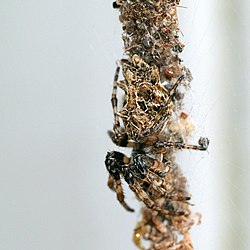| Cyclosa | |
|---|---|
 | |
| Camouflaged Cyclosa octotuberculata | |
 | |
| Cyclosa insulana | |
| Scientific classification | |
| Kingdom: | Animalia |
| Phylum: | Arthropoda |
| Subphylum: | Chelicerata |
| Class: | Arachnida |
| Order: | Araneae |
| Infraorder: | Araneomorphae |
| Family: | Araneidae |
| Genus: | Cyclosa Menge, 1866 |
| Type species | |
| C. conica (Pallas, 1772) | |
| Species | |
180, see text | |
Cyclosa, also called trashline orbweavers, [1] is a genus of orb-weaver spiders first described by Anton Menge in 1866. [2] Widely distributed worldwide, spiders of the genus Cyclosa build relatively small orb webs with a web decoration. The web decoration in Cyclosa spiders is often linear and includes prey remains and other debris, which probably serve to camouflage the spider. However, some tropical species, including C. longicauda in Peru, construct highly complex, non-linear stabilimenta that resemble the silhouette of a much larger orb-weaving spider. [3] This specific decoy strategy is hypothesized to serve as an advanced anti-predator defense by visual mimicry. [3] The name "Cyclosa" comes from Greek 'to move in a circle', referring to how it spins its web. [1]
Contents
While most orb-web spiders face downwards in their web when waiting for prey, some Cyclosa species (e.g. C. ginnaga and C. argenteoalba) face upwards. [4]
